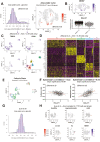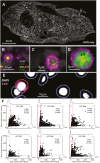Downregulation of MALAT1 is a hallmark of tissue and peripheral proliferative T cells in COVID-19
- PMID: 36869729
- PMCID: PMC10243916
- DOI: 10.1093/cei/uxad034
Downregulation of MALAT1 is a hallmark of tissue and peripheral proliferative T cells in COVID-19
Abstract
T cells play key protective but also pathogenic roles in COVID-19. We studied the expression of long non-coding RNAs (lncRNAs) in COVID-19 T-cell transcriptomes by integrating previously published single-cell RNA sequencing datasets. The long intergenic non-coding RNA MALAT1 was the most highly transcribed lncRNA in T cells, with Th1 cells demonstrating the lowest and CD8+ resident memory cells the highest MALAT1 expression, amongst CD4+ and CD8+ T-cells populations, respectively. We then identified gene signatures that covaried with MALAT1 in single T cells. A significantly higher number of transcripts correlated negatively with MALAT1 than those that correlated. Enriched functional annotations of the MALAT1- anti-correlating gene signature included processes associated with T-cell activation such as cell division, oxidative phosphorylation, and response to cytokine. The MALAT1 anti-correlating gene signature shared by both CD4+ and CD8+ T-cells marked dividing T cells in both the lung and blood of COVID-19 patients. Focussing on the tissue, we used an independent patient cohort of post-mortem COVID-19 lung samples and demonstrated that MALAT1 suppression was indeed a marker of MKI67+ proliferating CD8+ T cells. Our results reveal MALAT1 suppression and its associated gene signature are a hallmark of human proliferating T cells.
Keywords: COVID-19; MALAT1; T cell; lncRNA; proliferation.
© The Author(s) 2023. Published by Oxford University Press on behalf of the British Society for Immunology.
Conflict of interest statement
The authors declare no conflicts of interest.
Figures






Similar articles
-
Down-regulation of long non-coding RNA MALAT1 inhibits granulosa cell proliferation in endometriosis by up-regulating P21 via activation of the ERK/MAPK pathway.Mol Hum Reprod. 2019 Jan 1;25(1):17-29. doi: 10.1093/molehr/gay045. Mol Hum Reprod. 2019. PMID: 30371869
-
LncRNA MALAT1 promotes tumorigenesis and immune escape of diffuse large B cell lymphoma by sponging miR-195.Life Sci. 2019 Aug 15;231:116335. doi: 10.1016/j.lfs.2019.03.040. Epub 2019 Mar 18. Life Sci. 2019. PMID: 30898647
-
The long noncoding RNA Malat1 regulates CD8+ T cell differentiation by mediating epigenetic repression.J Exp Med. 2022 Jun 6;219(6):e20211756. doi: 10.1084/jem.20211756. Epub 2022 May 20. J Exp Med. 2022. PMID: 35593887 Free PMC article.
-
Multiple function of lncRNA MALAT1 in cancer occurrence and progression.Chem Biol Drug Des. 2023 May;101(5):1113-1137. doi: 10.1111/cbdd.14006. Epub 2022 Jan 31. Chem Biol Drug Des. 2023. PMID: 34918470 Review.
-
Functional roles of long noncoding RNA MALAT1 in gynecologic cancers.Clin Transl Oncol. 2023 Jan;25(1):48-65. doi: 10.1007/s12094-022-02914-8. Epub 2022 Aug 30. Clin Transl Oncol. 2023. PMID: 36042115 Review.
Cited by
-
Long COVID: Molecular Mechanisms and Detection Techniques.Int J Mol Sci. 2023 Dec 28;25(1):408. doi: 10.3390/ijms25010408. Int J Mol Sci. 2023. PMID: 38203577 Free PMC article. Review.
-
An integrated single-cell atlas of blood immune cells in aging.NPJ Aging. 2024 Nov 29;10(1):59. doi: 10.1038/s41514-024-00185-x. NPJ Aging. 2024. PMID: 39613786 Free PMC article.
-
Non-coding RNAs: emerging biomarkers and therapeutic targets in cancer and inflammatory diseases.Front Oncol. 2025 Mar 10;15:1534862. doi: 10.3389/fonc.2025.1534862. eCollection 2025. Front Oncol. 2025. PMID: 40129920 Free PMC article. Review.
-
Targeted Inhibition of lncRNA Malat1 Alters the Tumor Immune Microenvironment in Preclinical Syngeneic Mouse Models of Triple-Negative Breast Cancer.Cancer Immunol Res. 2023 Nov 1;11(11):1462-1479. doi: 10.1158/2326-6066.CIR-23-0045. Cancer Immunol Res. 2023. PMID: 37603945 Free PMC article.
References
Publication types
MeSH terms
Substances
Grants and funding
LinkOut - more resources
Full Text Sources
Medical
Research Materials

